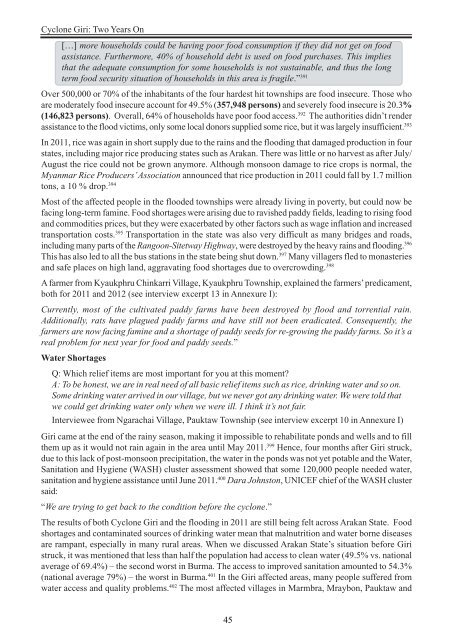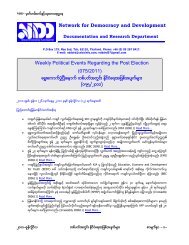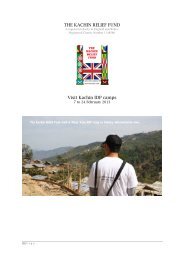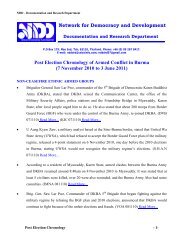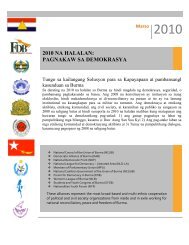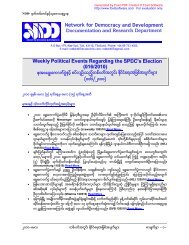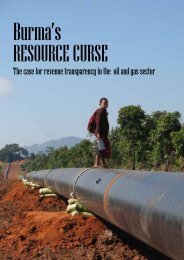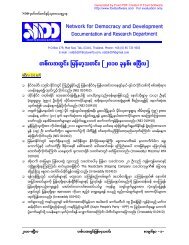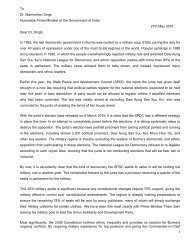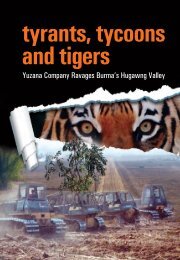Cyclone Giri - Two Years On - Burma Action Ireland
Cyclone Giri - Two Years On - Burma Action Ireland
Cyclone Giri - Two Years On - Burma Action Ireland
You also want an ePaper? Increase the reach of your titles
YUMPU automatically turns print PDFs into web optimized ePapers that Google loves.
<strong>Cyclone</strong> <strong>Giri</strong>: <strong>Two</strong> <strong>Years</strong> <strong>On</strong><br />
[…] more households could be having poor food consumption if they did not get on food<br />
assistance. Furthermore, 40% of household debt is used on food purchases. This implies<br />
that the adequate consumption for some households is not sustainable, and thus the long<br />
term food security situation of households in this area is fragile.” 391<br />
Over 500,000 or 70% of the inhabitants of the four hardest hit townships are food insecure. Those who<br />
are moderately food insecure account for 49.5% (357,948 persons) and severely food insecure is 20.3%<br />
(146,823 persons). Overall, 64% of households have poor food access. 392 The authorities didn’t render<br />
assistance to the flood victims, only some local donors supplied some rice, but it was largely insufficient. 393<br />
In 2011, rice was again in short supply due to the rains and the flooding that damaged production in four<br />
states, including major rice producing states such as Arakan. There was little or no harvest as after July/<br />
August the rice could not be grown anymore. Although monsoon damage to rice crops is normal, the<br />
Myanmar Rice Producers’ Association announced that rice production in 2011 could fall by 1.7 million<br />
tons, a 10 % drop. 394<br />
Most of the affected people in the flooded townships were already living in poverty, but could now be<br />
facing long-term famine. Food shortages were arising due to ravished paddy fields, leading to rising food<br />
and commodities prices, but they were exacerbated by other factors such as wage inflation and increased<br />
transportation costs. 395 Transportation in the state was also very difficult as many bridges and roads,<br />
including many parts of the Rangoon-Sitetway Highway, were destroyed by the heavy rains and flooding. 396<br />
This has also led to all the bus stations in the state being shut down. 397 Many villagers fled to monasteries<br />
and safe places on high land, aggravating food shortages due to overcrowding. 398<br />
A farmer from Kyaukphru Chinkarri Village, Kyaukphru Township, explained the farmers’ predicament,<br />
both for 2011 and 2012 (see interview excerpt 13 in Annexure I):<br />
Currently, most of the cultivated paddy farms have been destroyed by flood and torrential rain.<br />
Additionally, rats have plagued paddy farms and have still not been eradicated. Consequently, the<br />
farmers are now facing famine and a shortage of paddy seeds for re-growing the paddy farms. So it’s a<br />
real problem for next year for food and paddy seeds.”<br />
Water Shortages<br />
Q: Which relief items are most important for you at this moment<br />
A: To be honest, we are in real need of all basic relief items such as rice, drinking water and so on.<br />
Some drinking water arrived in our village, but we never got any drinking water. We were told that<br />
we could get drinking water only when we were ill. I think it’s not fair.<br />
Interviewee from Ngarachai Village, Pauktaw Township (see interview excerpt 10 in Annexure I)<br />
<strong>Giri</strong> came at the end of the rainy season, making it impossible to rehabilitate ponds and wells and to fill<br />
them up as it would not rain again in the area until May 2011. 399 Hence, four months after <strong>Giri</strong> struck,<br />
due to this lack of post-monsoon precipitation, the water in the ponds was not yet potable and the Water,<br />
Sanitation and Hygiene (WASH) cluster assessment showed that some 120,000 people needed water,<br />
sanitation and hygiene assistance until June 2011. 400 Dara Johnston, UNICEF chief of the WASH cluster<br />
said:<br />
“We are trying to get back to the condition before the cyclone.”<br />
The results of both <strong>Cyclone</strong> <strong>Giri</strong> and the flooding in 2011 are still being felt across Arakan State. Food<br />
shortages and contaminated sources of drinking water mean that malnutrition and water borne diseases<br />
are rampant, especially in many rural areas. When we discussed Arakan State’s situation before <strong>Giri</strong><br />
struck, it was mentioned that less than half the population had access to clean water (49.5% vs. national<br />
average of 69.4%) – the second worst in <strong>Burma</strong>. The access to improved sanitation amounted to 54.3%<br />
(national average 79%) – the worst in <strong>Burma</strong>. 401 In the <strong>Giri</strong> affected areas, many people suffered from<br />
water access and quality problems. 402 The most affected villages in Marmbra, Mraybon, Pauktaw and<br />
45


